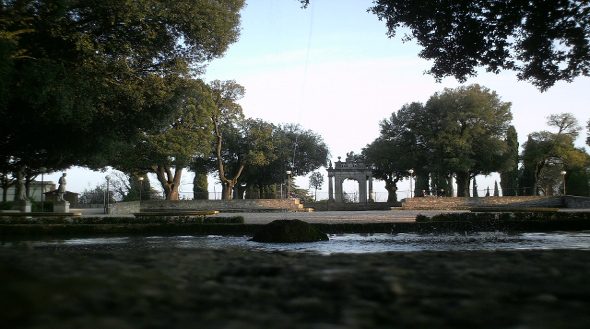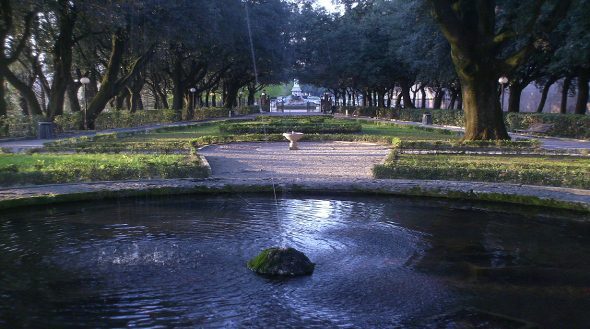I Giardini del Frontone costituiscono uno dei luoghi privilegiati dagli abitanti di Perugia, dove si recano in tanti per passeggiare nel verde, fare jogging o semplicemente rilassarsi seduti in una delle panchine del parco. Benché non grandissimi, quelli del Frontone sono dei giardini storici oltre che i primi giardino pubblici in assoluto della città.
Sono situati in fondo a Borgo XX Giugno, proprio adiacenti all’Abbazia di San Pietro, nel quartiere di Borgo Bello.
Completamente recintati e chiusi da apposita cancellata, presentano un sistema di aiuole centrali delimitato da quattro viali principali intercalati da vialetti secondari, che confluiscono nell’emiciclo terminale. Questo è caratterizzato dalla presenza di 6 statue che raffigurano le Arti e da un anfiteatro in travertino.
Scopriamone allora di più su questo luogo così caro ai perugini!

>> Visita i Giardini del Frontone durante il tuo soggiorno a Perugia, ti consigliamo i migliori agriturismi della zona
I Giardini del Frontone a Perugia
Sorti su un’area che ospitò in passato una necropoli etrusca e poi un forte difensivo da cui i perugini “fronteggiavano” il nemico, i giardini vennero realizzati dai poeti della Colonia Arcadica Augusta. Agli inizi del ‘700 venne delineata la configurazione attuale, creando un anfiteatro con gradoni di terra contornati da olmi e delimitando i viali con esemplari di specie esotiche.
Dopo un periodo di abbandono, verso il 1780 i giardini vennero risistemati dagli stessi Arcadi che sostituirono i gradoni di terra con gli attuali sedili di travertino, piantarono i lecci al posto degli olmi e costruirono un primo recinto murario. I cipressi che fiancheggiano i passaggi laterali vennero piantati nel 1780. Nel 1791 inoltre installarono l’arco di travertino disegnato da Baldassarre Orsini, collocandolo proprio al centro dell’anfiteatro.
Durante l’800 i giardini del Frontone vennero ulteriormente ristrutturati, con la realizzazione delle aiuole e della vasca centrale, l’ampliamento del recinto murario e la sostituzione delle specie esotiche con i lecci ancora presenti. Nel 1819 in particolare vennero piantati i Castagni d’India.
La creazione dell’ampia spianata che caratterizza il parco si deve a Braccio Fortebraccio da Montone, condottiero e signore di Perugia, che ne fece la piazza d’armi della città. Qui il 20 giugno 1859, alle 15:30 ebbe inizio lo scontro tra le truppe svizzere del colonnello Schimd e gli insorti perugini. Alla fine della giornata di combattimenti si contarono 53 morti, sommando le due parti in lotta, tra militari e civili.

>>Se hai deciso di vedere Perugia e di visitare Giardini del Frontone ti consigliamo di contattare ora gli agriturismi nelle sue vicinanze
Gli eventi ai Giardini
Come accennato, la vegetazione che decora i Giardini è semplice ma di gran pregio, costituita da esemplari ormai secolari di leccio e di siepi d’alloro e lentaggine. La natura rigogliosa e placida che caratterizza l’atmosfera del parco ne fa un luogo privilegiato per le passeggiate, ma non solo.
I Giardini del Frontone sono stati scelti negli anni come cornice di vari eventi che hanno interessato la città di Perugia. Per anni ad esempio hanno ospitato i concerti principali di Umbria Jazz, prima che il festival crescesse e rendesse necessario l’allestimento del main stage altrove per far fronte alle esigenze di capienza del pubblico.
Due volte l’anno, i giardini si prestano ad ospitare la bellissima manifestazione del Perugia Flower Show, la celebre mostra mercato di piante e fiori dedicata alla botanica e al giardinaggio. Inoltre, durante l’estate, al Frontone viene organizzato un cinema all’aperto in cui vengono proiettati film d’autore e uscite della stagione precedente.
Frontone Gardens are the first public park in the city of Perugia.
Completely fenced and closed by a special gate, they have a system of central flower beds bordered by four main avenues, interspersed with secondary pathways, which converge in the hemicycle terminal characterized by the presence of six statues representing the Arts and an amphitheater in travertine.
>> Do you want to visit Frontone Gardens? Contact now the best farmhouse in Perugia and discover their offers!

The gardens were created in an area that had first been an Etruscan necropolis and later a fort, from which the Perugians would face the enemy. They were designed by the poets of the Colonia Arcadica Augusta, who laid out the plan they still have today in the early 1700s, creating an amphitheater with earth tiers bordered by elms and lining the paths with exotic plant species. After a period of abandonment, in about 1780 the gardens were cleaned and fixed up by the Acadians again, who replaced the earth tiers with the present-day travertine seats, planted ilexes in place of the elms, and built a first fence. In 1791 they added the travertine arch designed by Baldassarre Orsini at the center of the amphitheater. During the 1800s the gardens were further renovated with the creating of the flower beds and the central basin, the expanding of the fencing and the replacing of the exotic plants with the ilexes, still standing majestically today.
>> There are offers in deadline! Click and consult list of the best hotels in Perugia!

The gardens have a simple but beautiful assortment of plants, with grand, centuries-old ilexes and laurel and laurustine hedges.
>>If you’ve decided to see Perugia and to visit the Frontone Gardens you should contact now houses in its vicinity >>click this link
Frontone Gardens are the first public park in the city of Perugia.
Completely fenced and closed by a special gate, they have a system of central flower beds bordered by four main avenues, interspersed with secondary pathways, which converge in the hemicycle terminal characterized by the presence of six statues representing the Arts and an amphitheater in travertine.
>> Do you want to visit Frontone Gardens? Contact now the best farmhouse in Perugia and discover their offers!

The gardens were created in an area that had first been an Etruscan necropolis and later a fort, from which the Perugians would face the enemy. They were designed by the poets of the Colonia Arcadica Augusta, who laid out the plan they still have today in the early 1700s, creating an amphitheater with earth tiers bordered by elms and lining the paths with exotic plant species. After a period of abandonment, in about 1780 the gardens were cleaned and fixed up by the Acadians again, who replaced the earth tiers with the present-day travertine seats, planted ilexes in place of the elms, and built a first fence. In 1791 they added the travertine arch designed by Baldassarre Orsini at the center of the amphitheater. During the 1800s the gardens were further renovated with the creating of the flower beds and the central basin, the expanding of the fencing and the replacing of the exotic plants with the ilexes, still standing majestically today.
>> There are offers in deadline! Click and consult list of the best hotels in Perugia!

The gardens have a simple but beautiful assortment of plants, with grand, centuries-old ilexes and laurel and laurustine hedges.
>>If you’ve decided to see Perugia and to visit the Frontone Gardens you should contact now houses in its vicinity >>click this link
Frontone Gardens are the first public park in the city of Perugia.
Completely fenced and closed by a special gate, they have a system of central flower beds bordered by four main avenues, interspersed with secondary pathways, which converge in the hemicycle terminal characterized by the presence of six statues representing the Arts and an amphitheater in travertine.
>> Do you want to visit Frontone Gardens? Contact now the best farmhouse in Perugia and discover their offers!

The gardens were created in an area that had first been an Etruscan necropolis and later a fort, from which the Perugians would face the enemy. They were designed by the poets of the Colonia Arcadica Augusta, who laid out the plan they still have today in the early 1700s, creating an amphitheater with earth tiers bordered by elms and lining the paths with exotic plant species. After a period of abandonment, in about 1780 the gardens were cleaned and fixed up by the Acadians again, who replaced the earth tiers with the present-day travertine seats, planted ilexes in place of the elms, and built a first fence. In 1791 they added the travertine arch designed by Baldassarre Orsini at the center of the amphitheater. During the 1800s the gardens were further renovated with the creating of the flower beds and the central basin, the expanding of the fencing and the replacing of the exotic plants with the ilexes, still standing majestically today.
>> There are offers in deadline! Click and consult list of the best hotels in Perugia!

The gardens have a simple but beautiful assortment of plants, with grand, centuries-old ilexes and laurel and laurustine hedges.
>>If you’ve decided to see Perugia and to visit the Frontone Gardens you should contact now houses in its vicinity >>click this link
Frontone Gardens are the first public park in the city of Perugia.
Completely fenced and closed by a special gate, they have a system of central flower beds bordered by four main avenues, interspersed with secondary pathways, which converge in the hemicycle terminal characterized by the presence of six statues representing the Arts and an amphitheater in travertine.
>> Do you want to visit Frontone Gardens? Contact now the best farmhouse in Perugia and discover their offers!

The gardens were created in an area that had first been an Etruscan necropolis and later a fort, from which the Perugians would face the enemy. They were designed by the poets of the Colonia Arcadica Augusta, who laid out the plan they still have today in the early 1700s, creating an amphitheater with earth tiers bordered by elms and lining the paths with exotic plant species. After a period of abandonment, in about 1780 the gardens were cleaned and fixed up by the Acadians again, who replaced the earth tiers with the present-day travertine seats, planted ilexes in place of the elms, and built a first fence. In 1791 they added the travertine arch designed by Baldassarre Orsini at the center of the amphitheater. During the 1800s the gardens were further renovated with the creating of the flower beds and the central basin, the expanding of the fencing and the replacing of the exotic plants with the ilexes, still standing majestically today.
>> There are offers in deadline! Click and consult list of the best hotels in Perugia!

The gardens have a simple but beautiful assortment of plants, with grand, centuries-old ilexes and laurel and laurustine hedges.
>>If you’ve decided to see Perugia and to visit the Frontone Gardens you should contact now houses in its vicinity >>click this link



Comment (0)